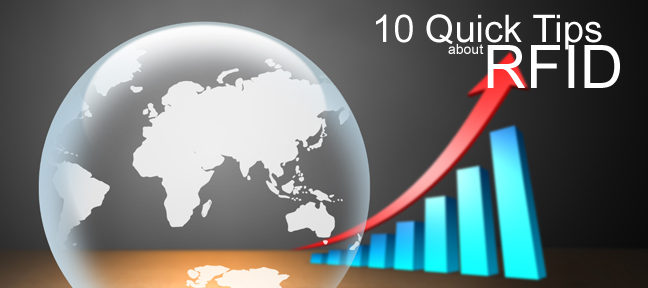
16 Apr 10 Quick Tips About RFID
Follow these 10 Quick tips about RFID to save time and money:
About RFID Tags and Readers
1. Understanding Passive vs. Active
There are RFID tags and RFID readers that need to be used together. RFID tags are attached to IT assets and can be “active” or “passive.” Active tags will initiate a signal (typically on a timer).
Use the following table to see the differences between them.
|
|
Passive |
Active |
| Read Range | Up to 40 feet (fixed readers) Up to 20 feet (handheld readers) |
Up to 300 feet or more |
| Power | No power source | Battery powered |
| Tag Life | Up to 10 years depending upon the environment the tag is used in | 3-8 years depending upon the tag broadcast rate |
| Tag Costs | $.10 – $4 or more depending upon quantity, durability, and form-factor | $15 – $50 depending upon quantity, options (motion sensor, tamper detection, temperature sensor), and form-factor |
| Ideal Use | For inventorying assets using handheld RFID readers (daily, weekly, monthly quarterly, annually). Can also be used with fixed RFID readers to track the movement of assets as long as security is not a requirement. | For use with fixed RFID readers to perform real-time asset monitoring at chokepoints or within zones. Typically necessary when security is a requirement. |
| Readers | Typically higher cost. | Typically lower cost |
Media Selection & Handling
2. Match the chip position to the printer/encoder
Media may not be compatible among different brands of printer/encoders that support the same RFID protocol.
3. Request media samples or place a small initial order for testing purposes
It is critical that your media provider conforms to these specifications when designing media to fit your application. In order to verify that the specifications were followed, end users should obtain samples.
4. Take into account Storage Temperature
Media should be able to withstand any special circumstances that your business requires. (ie: extreme heat or cold and long/short term performance)
5. Limit Electro-static Discharge (ESD)
Protect and ensure performance by avoiding low-humidity and high-altitude locations. Storing media in cartons (cardboard is sufficient) will protect against ESD damage.
6. No foil or metal-based media
RF signals are reflected by metal and is a leading source of RFID interference.
7. Label Placement
Proximity to metal and liquid should be avoided.
Printer Management
8. Printer Placement
Avoid RF interference by allowing plenty of physical space between printer/encoder and other RF products that share the same bandwidth (antennas, readers, wireless phones, etc.)
9. Maximize Encoding Success
A key consideration in facilitating smooth printing/encoding operations is to ensure that the label edge is property aligned so that the tag is in proper programmable position for encoding. Best practice is to adjust label location through printer/encode commands or through label-design software
10. Research Management Applications
Avoid downtime and system shutdowns. Using the right printer and print-server management application can allow monitoring of RFID printer/encoders, setting alerts for persistent problems, and capturing statistical data on performance.
Need More?
Request our RFID Quick Guide: 10 questions you need to ask before implementing an RFID Solution.
Looking for more information about RFID? Contact us today 800-281-3056

Sorry, the comment form is closed at this time.